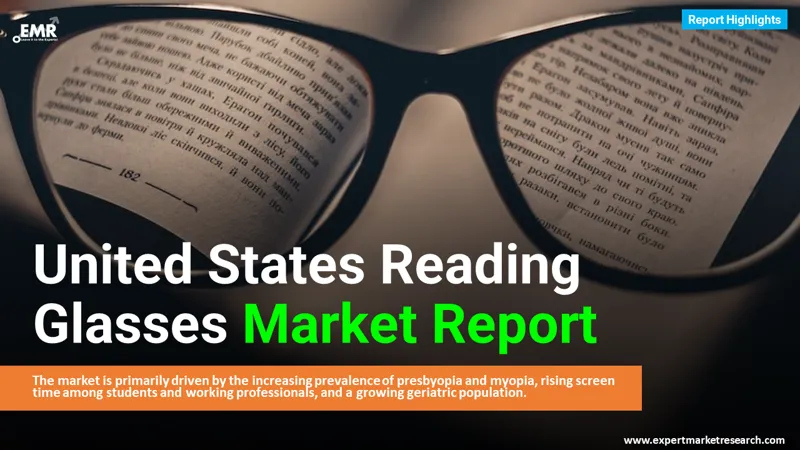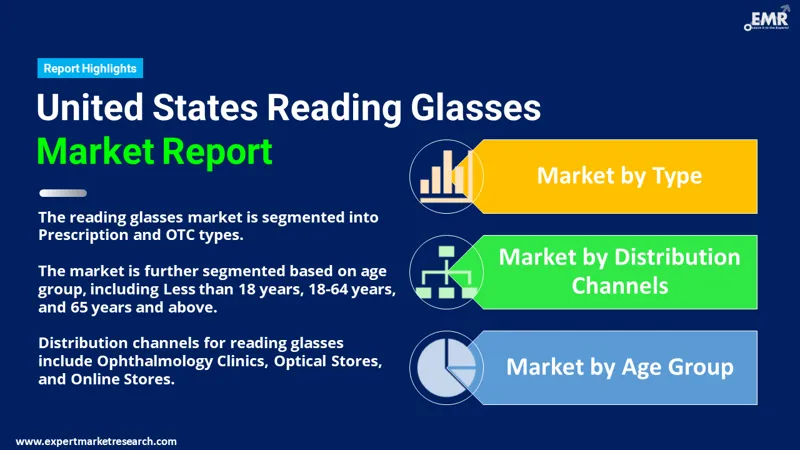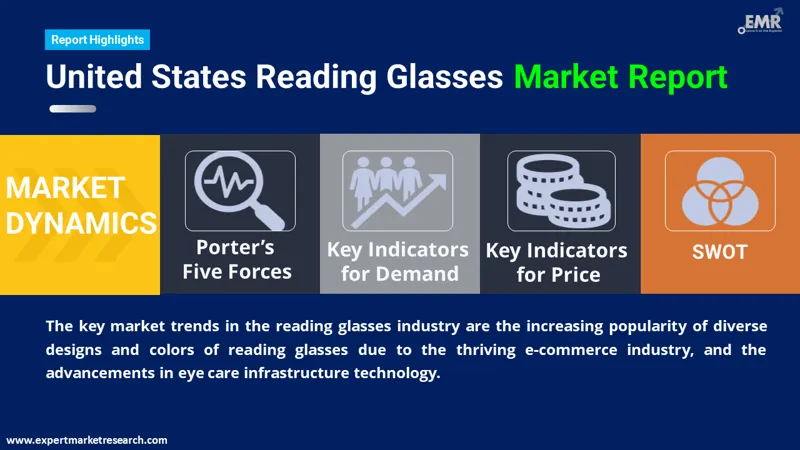
Consumer Insights
Uncover trends and behaviors shaping consumer choices today
Procurement Insights
Optimize your sourcing strategy with key market data
Industry Stats
Stay ahead with the latest trends and market analysis.
The United States reading glasses market was valued at USD 17.45 Billion in 2025 and is expected to grow at a CAGR of 5.40%, reaching USD 29.53 Billion by 2035. Growth is fueled by rising prevalence of vision impairment and increasing demand for corrective eyewear.
Base Year
Historical Period
Forecast Period
Compound Annual Growth Rate
5.4%
Value in USD Billion
2026-2035
*this image is indicative*
It is reported that nearly 28 million Americans wear over-the-counter reading glasses. While reading glasses are available in over-the-counter as well as prescription forms, and often used by people who have not earlier needed eyeglasses. In most people, presbyopia begins to show its effect as they near 40 to 50 years of age. Presbyopia is an age-related condition that prevents natural lenses from focusing up close. People affected by presbyopia may experience significant problems, and reading can become a challenging activity. Individuals with presbyopia may experience eye strain, headaches, and blurred vision, and might have to hold the device or book farther away to clearly see. The solution to the problem may require reading glasses, and such need is likely to drive the United States reading glasses market.

Read more about this report - REQUEST FREE SAMPLE COPY IN PDF
College students are more likely to become myopic and require reading glasses. Reading glasses offer a simple and practical solution to steady college myopia. Correcting people’s vision through eyeglasses promotes socioeconomic development. For example, correcting vision in children has been shown to lead to improved test scores enhanced academic performance. Correcting vision in adults leads to faster economic return through enhanced productivity. Vision correction in adults enables them to stay in the workforce for a longer duration.
It is reported that drivers having poor vision (correctable through glasses) are significantly more likely to be involved in road accidents. Clear vision is important to the maximization of use of application-based technology tools becoming more accessible with increased penetration of affordable smartphones in less developed nations. Such need is expected to boost the United States reading glasses market.
Reading glasses are generally non-prescription lenses that magnify the text on the device or page, making it easier to read; larger words help eyes focus quickly on the text. This decreases eye strain, making reading more comfortable. Modern alternatives like Varilux progressive lenses can be worn all the time without having to take the glasses off, switch them, or look over the top of the glasses.

Read more about this report - REQUEST FREE SAMPLE COPY IN PDF
The EMR’s report titled “United States Reading Glasses Market Report and Forecast 2026-2035” offers a detailed analysis of the market based on the following segments:
Market Breakup by Type
Market Breakup by Age Group
Market Breakup by Distribution Channels
Market Breakup by Region

Read more about this report - REQUEST FREE SAMPLE COPY IN PDF
The report offers an extensive assessment of major players in the United States Reading Glasses market; it evaluates their capability, observes latest occurrences such as mergers and acquisitions, capacity expansions, and plant turnarounds:
Using SWOT analysis and Porter’s Five Forces model, the EMR report offers deep insights into the industry.




*While we strive to always give you current and accurate information, the numbers depicted on the website are indicative and may differ from the actual numbers in the main report. At Expert Market Research, we aim to bring you the latest insights and trends in the market. Using our analyses and forecasts, stakeholders can understand the market dynamics, navigate challenges, and capitalize on opportunities to make data-driven strategic decisions.*
Get in touch with us for a customized solution tailored to your unique requirements and save upto 35%!
The market is estimated to grow at a CAGR of 5.40% in the forecast period of 2026 and 2035.
The major drivers of the market include the growing awareness pertaining to presbyopia and myopia, extensive screen time usage by students and working professionals, and increasing geriatric population.
The thriving e-commerce industry which is infusing the popularity of reading glasses of diverse designs and colours, and technological advancements in the eye care infrastructure in the country, are the key trends in the market.
Prescription and OTC are the different types of reading glasses.
Less than 18 years, 18-64 years, and 65 years and above, are the various age groups of reading glasses wearers.
The major players in the United States reading glasses market report are Guccio Gucci S.p.A., Eyebobs, ThinOptics, Inc., Bausch & Lomb Incorporated, Vera Bradley Designs, Inc., ICU Eyewear, Inc., Hi-Tech Optical, Inc., Warby Parker Inc., Zenni Optical, Inc., and Shark Eyes, Inc., among others.
Yes, reading glasses can be worn all day, however, wearing these glasses while driving or playing a sport might cause headache.
Strength of +1.00 is the most common magnification for reading glasses.
Explore our key highlights of the report and gain a concise overview of key findings, trends, and actionable insights that will empower your strategic decisions.
| REPORT FEATURES | DETAILS |
| Base Year | 2025 |
| Historical Period | 2019-2025 |
| Forecast Period | 2026-2035 |
| Scope of the Report |
Historical and Forecast Trends, Industry Drivers and Constraints, Historical and Forecast Market Analysis by Segment:
|
| Breakup by Type |
|
| Breakup by Age Group |
|
| Breakup by Distribution Channels |
|
| Breakup by Region |
|
| Market Dynamics |
|
| Competitive Landscape |
|
| Companies Covered |
|
Datasheet
One User
USD 1,999
USD 1,799
tax inclusive*
Single User License
One User
USD 3,099
USD 2,789
tax inclusive*
Five User License
Five User
USD 4,599
USD 3,909
tax inclusive*
Corporate License
Unlimited Users
USD 5,999
USD 5,099
tax inclusive*
*Please note that the prices mentioned below are starting prices for each bundle type. Kindly contact our team for further details.*
Flash Bundle
Small Business Bundle
Growth Bundle
Enterprise Bundle
*Please note that the prices mentioned below are starting prices for each bundle type. Kindly contact our team for further details.*
Flash Bundle
Number of Reports: 3
20%
tax inclusive*
Small Business Bundle
Number of Reports: 5
25%
tax inclusive*
Growth Bundle
Number of Reports: 8
30%
tax inclusive*
Enterprise Bundle
Number of Reports: 10
35%
tax inclusive*
How To Order

Select License Type
Choose the right license for your needs and access rights.

Click on ‘Buy Now’
Add the report to your cart with one click and proceed to register.

Select Mode of Payment
Choose a payment option for a secure checkout. You will be redirected accordingly.
Gain insights to stay ahead and seize opportunities.

Get insights & trends for a competitive edge.

Track prices with detailed trend reports.

Analyse trade data for supply chain insights.

Leverage cost reports for smart savings

Enhance supply chain with partnerships.

Connect For More Information
Our expert team of analysts will offer full support and resolve any queries regarding the report, before and after the purchase.
Our expert team of analysts will offer full support and resolve any queries regarding the report, before and after the purchase.
We employ meticulous research methods, blending advanced analytics and expert insights to deliver accurate, actionable industry intelligence, staying ahead of competitors.
Our skilled analysts offer unparalleled competitive advantage with detailed insights on current and emerging markets, ensuring your strategic edge.
We offer an in-depth yet simplified presentation of industry insights and analysis to meet your specific requirements effectively.
Share